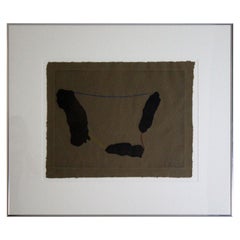Vintage Picture Fram
Recent Sales
1970s Vintage Picture Fram
Paper
Helen Frankenthaler for sale on 1stDibs
Prolific and pioneering painter Helen Frankenthaler said it was “a combination of impatience, laziness and innovation” that drove her to thin her paints with turpentine so that they would seep into the fabric of an unprimed canvas. Her breakthrough in the early 1950s led the way for a spellbinding new style of painting that would come to be known as Color Field.
Although Color Field is often considered a strain of Abstract Expressionism, Frankenthaler’s work differed from the gestural “Action Painting” that typified the paintings of artists like Willem de Kooning and Lee Krasner. Her vast and immersive expanses of color created at a fearless scale captivated art critics and greatly influenced her peers including Morris Louis and Kenneth Noland.
Frankenthaler knew from an early age that she wanted to be a painter. The youngest daughter of a New York State Supreme Court justice, she grew up on Manhattan’s Park Avenue and as a child delighted in the little ways color and form revealed themselves, whether dribbling red nail polish in a sink full of water or drawing her steps from the Metropolitan Museum of Art to her family’s apartment. As a student at Bennington College, her rare vision was enriched by the mentorship of painter Paul Feeley, who gave her lessons in Cubism. After dabbling in art history at Columbia University, she rented a studio downtown and befriended rising New York art stars like Jackson Pollock and Robert Motherwell, whom she later married.
Characterized by “direct, exuberant gestures,” the Abstract Expressionist technique was all about gusto, and Frankenthaler had it in spades. One of the few women of this era to garner widespread critical acclaim, Frankenthaler had a significant impact on the mid-20th-century art world. She exhibited in the high-profile 1951 Ninth Street Show and, in 1957, she appeared in a Life magazine spread on women artists photographed by Gordon Parks. In 1960, the Jewish Museum held her first major museum show, a retrospective of her 1950s work. A 1969 solo exhibition at the Whitney Museum of American Art further introduced Frankenthaler to the broader art world.
While Frankenthaler remains best known for bold, expressive “soak-stain” paintings such as Mountains and Sea (1952), she worked across diverse media for decades, with forays into woodcutting, drawing and printmaking that also pushed boundaries. She also taught at Harvard, Yale and Princeton, fostering generations of artists. She died in 2011.
Find original Helen Frankenthaler art on 1stDibs.
Finding the Right prints for You
Prints are works of art produced in multiple editions. Though several copies of a specific artwork can exist, collectors consider antique and vintage prints originals when they have been manually created by the artist or are “impressions” that are part of the artist’s intent for the work.
Modern artists use a range of printmaking techniques to produce different types of prints such as relief, intaglio and planographic. Relief prints are created by cutting away a printing surface to leave only a design. Ink or paint is applied to the raised parts of the surface, and it is used to stamp or press the design onto paper or another surface. Relief prints include woodcuts, linocuts and engravings.
Intaglio prints are the opposite of relief prints in that they are incised into the printing surface. The artist cuts the design into a block, plate or other material and then coats it with ink before wiping off the surface and transferring the design to paper through tremendous pressure. Intaglio prints have plate marks showing the impression of the original block or plate as it was pressed onto the paper.
Artists create planographic prints by drawing a design on a stone or metal plate using a grease crayon. The plate is washed with water, then ink is spread over the plate and it adheres to the grease markings. The image is then stamped on paper to make prints.
All of these printmaking methods have an intricate process, although each can usually transfer only one color of ink. Artists use separate plates or blocks for multiple colors, and together these create one finished work of art.
Find prints ranging from the 18th- and 19th-century bird illustrations by J.C. Sepp to mid-century modern prints, as well as numerous other antique and vintage prints at 1stDibs. Browse the collection today and read about how to arrange wall art in your space.
